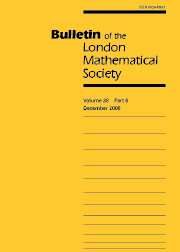Article contents
ON THE RANGES OF EIGENFUNCTIONS ON COMPACT MANIFOLDS
Published online by Cambridge University Press: 01 November 1998
Abstract
The aim of this note is to give a sharp upper bound on the ratio
formula here
where ϕ is a nonconstant eigenfunction for the Laplace–Beltrami operator on a connected compact Riemannian manifold without boundary. This ratio is always positive, since maxϕ>0 and minϕ<0 for every nonconstant eigenfunction. We assume that maxϕ[ges ]−minϕ, in order to simplify the notation. For the case of a two-dimensional manifold with nonnegative Ricci curvature, our theorem implies that the above ratio is less than the ratio of the maximum divided by the absolute value of the minimum of the Bessel function of order zero.
The proof is based on a gradient estimate from a previous paper of the author (see [5]), which in turn was proved using the maximum principle technique. In contrast to the standard applications of gradient estimates, which are based on integration along geodesics, we arrive at a contradiction by integrating the gradient estimate over small spheres centred at a point where the absolute value of the eigenfunction attains its maximum.
The main motivation for our work is that the ratio of the maximum and the minimum of an eigenfunction plays a role in estimates of the corresponding eigenvalues (see [5] and [7]). More precisely, our theorem implies that there are minimizing sequences of compact manifolds such that the first eigenvalues of the manifolds approach the corresponding lower bound for the first eigenvalue obtained in [5, Theorem 2] for every possible ratio of the maximum and the minimum of the corresponding eigenfunction.
- Type
- Notes and Papers
- Information
- Copyright
- © The London Mathematical Society 1998
- 1
- Cited by




